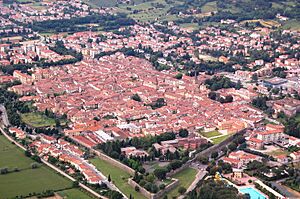Sansepolcro facts for kids
Quick facts for kids
Sansepolcro
|
|
|---|---|
| Città di Sansepolcro | |

Aerial view of Sansepolcro.
|
|
| Country | Italy |
| Region | Tuscany |
| Province | Arezzo (AR) |
| Frazioni | Aboca, Gragnano, Gricignano, Melello, Montagna, Santa Fiora |
| Area | |
| • Total | 91.48 km2 (35.32 sq mi) |
| Elevation | 330 m (1,080 ft) |
| Population
(31 December 2014)
|
|
| • Total | 16,012 |
| • Density | 175.033/km2 (453.33/sq mi) |
| Demonym(s) | Biturgensi - Borghesi |
| Time zone | UTC+1 (CET) |
| • Summer (DST) | UTC+2 (CEST) |
| Postal code |
52037
|
| Dialing code | 0575 |
| Patron saint | St. John the Evangelist |
| Saint day | December 27 |
| Website | www.comune.sansepolcro.ar.it |
Sansepolcro, once called Borgo Santo Sepolcro, is a cool town in the Tuscany region of Italy. It's found in the eastern part of the Province of Arezzo, right by the Tiber river. This town has been around since the 11th century!
Sansepolcro is famous for being the hometown of many talented people. Great painters like Piero della Francesca, Raffaellino del Colle (who learned from Raphael), Matteo di Giovanni, Santi di Tito, and Angiolo Tricca were born here. Also, the clever Italian mathematician Luca Pacioli came from Sansepolcro.
Today, the town's economy is based on farming, making things in factories, preparing food, and medicines. It's even where the well-known Buitoni pasta started, founded by Giulia Buitoni in 1827.
Contents
History of Sansepolcro
The story of Sansepolcro's beginning is quite interesting. It's said that two pilgrims, Arcanus and Giles, traveled to the Holy Land in the 9th century. When they came back, they built a small chapel dedicated to Saint Leonard. They decided to live a simple, monastic life there. Later, the main church of Sansepolcro was built on the ruins of this old chapel.
These pilgrims brought a special stone from the Church of the Holy Sepulchre in Jerusalem. This stone was placed in their monastery, and that's how the town got its name, "San Sepolcro," meaning "Holy Sepulchre." The place became popular for pilgrimages. The church later became a big Benedictine Abbey.
The first official records of Sansepolcro are from 1012. They talk about the monastery being built, and a small community, or commune, growing around it. The Holy Roman Emperor Conrad II, Holy Roman Emperor even declared it a market town, which helped it grow. Later, the abbey joined with the Camaldolese Order of monks.
In the 13th century, Sansepolcro was important because it was on key trade routes. Different groups fought to control it. It was ruled by people like Uguccione della Faggiola and Guido Tarlati. Eventually, it came under the control of the Papal States. In 1367, Pope Urban V gave the town to the Malatesta family.
Later, in the 15th century, the Republic of Florence took control, with the Pope's approval. About a hundred years later, Pope Leo X made Sansepolcro an official city.
During World War II, Sansepolcro was almost destroyed. But a brave British officer named Tony Clarke stopped the Allied army from attacking. He did this to save a famous painting by Piero della Francesca called Resurrection. Thanks to him, this amazing artwork was saved!
Main Sights in Sansepolcro
The most important church in Sansepolcro is the Cathedral of St. John the Evangelist. It was built between 1012 and 1049 in a mix of Gothic and Romanesque styles. Other notable churches include San Francesco and San Lorenzo. The San Lorenzo church has a famous painting called Deposition by Rosso Fiorentino.
You can find the amazing Resurrection painting by Piero della Francesca in the Museo Civico. The English writer Aldous Huxley once called it "the greatest painting in the world." This museum also has three other works by Piero della Francesca and many other valuable artworks by artists like Santi di Tito, Raffaellino del Colle, and Luca Signorelli.
International Connections
Sansepolcro is connected with other towns around the world through a program called twinning. This helps towns share cultures and ideas.
Sister cities
Sansepolcro is twinned with:
 Neuchâtel, Switzerland
Neuchâtel, Switzerland Neuves-Maisons, France
Neuves-Maisons, France Sinj, Croatia
Sinj, Croatia
See also
 In Spanish: Sansepolcro para niños
In Spanish: Sansepolcro para niños

